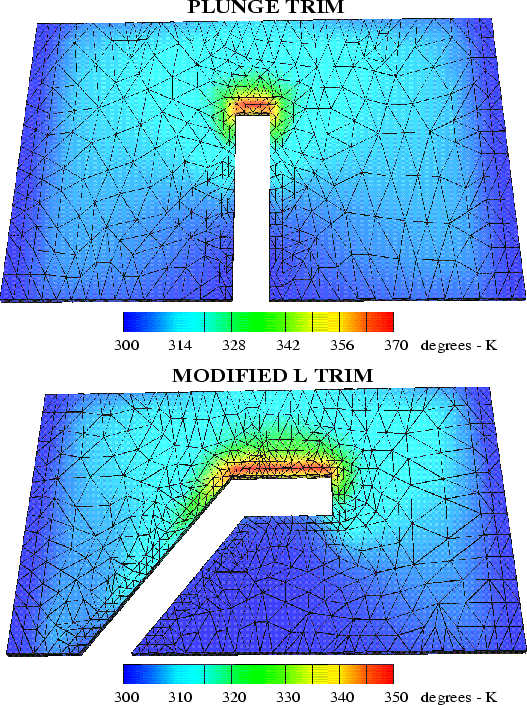The performance of laser trimmed resistors is related to the so called Heat-Affected Zone (HAZ) [91], formed during the trimming process. The HAZ corresponds to a region along the edge that being heavily heated (but still below the vaporization temperature) after cooling suffers an alteration in its physical properties, namely in the sheet resistance, temperature coefficient and aging.
We model the sheet
resistance of HAZ as in [91]. The use of parameterized
layout generation facilitates the preparation of sets corresponding
to different lengths of the laser cut. The
simulated structures are then formed directly from the layout, and are made
of a silicon substrate, a SiO![]() layer, the high-resistivity polysilicon
resistor layer and finally, a
passivation SiO
layer, the high-resistivity polysilicon
resistor layer and finally, a
passivation SiO![]() layer. The bottom of the silicon substrate
is kept at a constant
temperature of 300
layer. The bottom of the silicon substrate
is kept at a constant
temperature of 300![]() K. We compared the classical plunge trim and a
modified L trim resistor (see Figure 7.15) with the
same dimensions and geometry before trim. The target resistance
is 1000
K. We compared the classical plunge trim and a
modified L trim resistor (see Figure 7.15) with the
same dimensions and geometry before trim. The target resistance
is 1000![]() for both resistors.
for both resistors.
Figure 7.14 shows the dependence of the resistance
value as function of the cut-length. As near 1000![]() the sensitivity
is much lower in the modified L-trim, its better accuracy is evident. In
Figure 7.15 we
present the temperature distribution along the resistors when dissipating
the same overall power. We can see
the crowding effect in the HAZ (corresponding to the maximum values in the
current and temperature) and that for the same overall power dissipation, the
maximum temperature is 20
the sensitivity
is much lower in the modified L-trim, its better accuracy is evident. In
Figure 7.15 we
present the temperature distribution along the resistors when dissipating
the same overall power. We can see
the crowding effect in the HAZ (corresponding to the maximum values in the
current and temperature) and that for the same overall power dissipation, the
maximum temperature is 20![]() C lower in the modified L trim resistor. This
predicts a much more stable aging of resistors using this trim algorithm.
C lower in the modified L trim resistor. This
predicts a much more stable aging of resistors using this trim algorithm.
 |